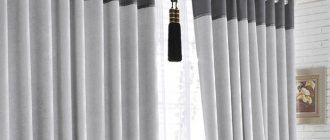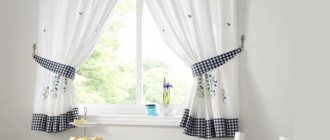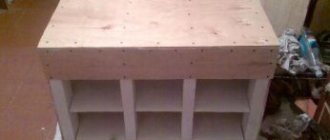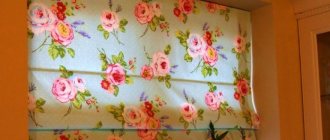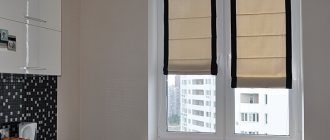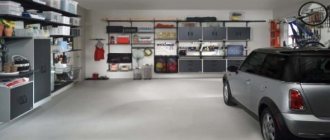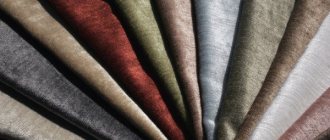In the design of modern interiors, a new interesting format for attaching curtains has appeared - these are curtains with hinges. They are quite easy to make with your own hands with step-by-step instructions. You will need a piece of fabric of the required size, threads in color and a machine.
In stores you can find a huge amount of material suitable for this purpose.
Before you begin, you will need to take measurements of your window - and this moment will perhaps be the most difficult! Otherwise, creating a curtain with hinges with your own hands is very simple.
Choosing material for curtains
Such curtains are perfect for any interior - kitchen or living room - it doesn’t matter! Usually, to sew them, they take coarse, dense fabric with sewn loops, with which the curtain is attached to the cornice. But you shouldn’t rush and sew on the loops tightly - it’s better to make them removable.
In general, the classic version looks very simple, but excess restraint can be eliminated by adding additional decorativeness. Replace linen or cotton with airy organza, patterned jacquard, or combine materials of different textures and shades, change the shape of the loops. Then no one will be able to say that a curtain with hinges, made with your own hands, is boring and uninteresting!
When choosing a material, consider for what purposes will you need it?
For example, to block drafts and bright sunlight, it is optimal to take dense fabric - velvet, corduroy, tapestry. If you don’t want to block out the sun, but views from the street are disturbing, buy a thick organza or curtain veil. Well, for an airy curtain, say, in an attic room, various types of tulle, chiffon or thin organza are suitable.
Thread
Thread curtains can be either an independent element of window decor or an addition to transparent tulle or thick curtains. The material used is synthetic thread, which is often decorated with beads or bugles. Thick tape or a thin wooden plank is suitable for fastening. The threads are placed at a distance of 2-3 mm from each other, secured with a loop, fixed with glue or stitched.
Particularly worth noting are the curtains made using the macrame technique. They fit perfectly into boho, Provence or Scandi style interiors. The weightless wicker fabric lets in most of the sunlight, but protects passers-by and neighbors living opposite from prying eyes. Curtains made using the macrame technique will appeal to those who prefer light, airy interiors with notes of ethnicity and shabby chic.
Needlewomen who already have experience working with knotting techniques can weave a fabric that spans the entire height of a window. Beginning craftswomen can limit themselves to a simple pattern 20-30 centimeters high at the top of the curtain, and leave the remaining length as a hanging fringe. To work, you will need a cotton cord, jute or silk thread, crochet hooks and a wooden base, which can later be used as a cornice.
Before you start creating curtains, you should master several basic knots:
- Flat;
- Square or double flat;
- Rep (horizontal and vertical);
- Eight;
- Petelny and others.
By combining knots with each other, you can adjust the density of the weaving and create more and more new patterns each time.
Types of hinge fastening
At the beginning of the process of creating curtains with hinges with your own hands, decide what shape the hinges will have.
- Simple rectangular - when strips of fabric (the same one from which the curtain is sewn or a contrasting one) are attached to the top of the canvas. This type of fixation is called blind - if you don’t remove the curtain rod, you won’t be able to remove the curtain.
- Tapered or rounded loop strip in the stitching area.
- Model - regular lace, ribbons, ribbon - decorated with bows or knots.
- Loops with fasteners (buttons, Velcro, denim loops) are perhaps the most practical of all options. This method makes it very easy to remove curtains without disassembling the curtain rod. Suitable for the kitchen, because this is where the curtain gets dirty the fastest.
- Crocheted Stitches - All knitters can make stitches using a crochet hook.
In different styles
Loop curtain mounting options are compatible with the following interior styles:
- Classical. When decorating a window opening, the usual lambrequin can be replaced with bows or cords to match the curtains. The tiebacks are decorated in the same way.
- Romantic styles. For such trends as Provence, retro, shabby chic, fasteners-ties, decorated with braid or ribbon in the form of bows or knots, are suitable. For loop fastenings, choose fabric in delicate shades: pink, lilac, pistachio, use lace and ruffles.
Romantic Provence Source homeli.ru
- Country styles. In a country interior, loops made of cotton and linen, perhaps with embroidery or stripes, would be appropriate. For the living room of the chalet, choose thin wool or satin; you can use fur (if the room is decorated with a carpet in the shape of an animal skin).
- Loft, hi-tech. You can diversify the design using cotton ropes, mini ropes and laces.
- Loft, eclectic, techno. It is possible to use fabric with a metallic sheen.
- Pop art, fusion, kitsch. Experiment with bright colors, the most extravagant colors.
On cotton laces Source 3.bp.blogspot.com
Selection of cornices and curtain design
Curtains with hinges, created with your own hands and selected according to your taste, you can attach to any rod, not necessarily round! This product looks great on any structure - plastic, wood or aluminum. The only condition when installing such curtain rods is that they are mounted slightly higher than usual - about 11-12 cm from the top of the window opening. Otherwise, there will be a gap between the curtain and the rod, and this will negatively affect the appearance.
Loops sewn from fabric of a different color look very nice. You can cover the buttons with bright fabric and the curtain will take on an interesting and funny character. You can choose wooden buttons - it looks amazing with a wooden cornice!
You can increase the height of the room by using curtains with a vertical pattern, and, conversely, horizontal placement of stripes and patterns visually expands a cramped room.
Material consumption
Never start sewing without taking the necessary measurements. To get a high-quality result, calculate all the dimensions of the parts, the required number of loops, carefully cut them and only then start sewing curtains with loops with your own hands. Step by step it looks like this.
The first step is to measure the width of the window that the curtain will cover. Next, we multiply the resulting number by two or two and a half - this depends on the splendor of the future curtain in the retracted position. Along the perimeter you need to add 11 cm per hem.
Now we measure the gap between the curtain rod and the top edge of the window. This is done to prevent the curtain fabric from sagging. Make sure that this measurement is greater than the height of the curtain loop.
There are several options for curtain lengths:
- Directly to the floor level - for formal or elegant rooms.
- Add 10-14 cm to the length to the floor - this increase will give the effect of romance.
- Curtains that extend to the windowsill are ideal for the kitchen or bathroom.
- Short curtains that cover a small part of the opening. Typically used in kitchens.
When the loops are sewn on, you need to trim the top of the curtain using a facing. Cut out a strip of material about eleven centimeters wide and a length equal to the wide edge of the curtain, not forgetting to leave 4 cm for the hem.
Final stage
Position the trim strip so that on the lining side of the panel, the folded edge of the back of the trim strip hides the open seam. Attach it with a pin to the canvas. Sew along all four sides of the strip. This stitching will be visible, so be very careful to keep the seam line straight and remember to turn at each corner.
Finish the bottom edge of the curtain in the same way, using the second trim strip, but without the tape. Repeat these steps so that the second curtain sheet matches the first.
Found a violation? Report content
Sewing classic curtains with hinges with your own hands: master class
The most practical option is the classic one. The work of making it will not take you much time.
As a result of all the measurements and calculations, start cutting out the material - the curtain panel, the details of the loops and the facing, and start sewing curtains with hinges with your own hands.
In order to sew the loops, several rectangles are cut out with the desired side size, about 14 by 22.
Next, fold all the rectangles in half, right sides inward. Seams are laid along the long sides of the workpieces, retreating 2 cm from the edge. Iron each seam and turn it right side out. Straighten so that the seams go in the middle of each part and iron again. The result is strips 5 cm wide and 22 cm long.
Now bend them in half and sew them to the top edge of the curtain.
Fold the facing along the short sides by 2 cm, and along the long sides by 1 cm and iron it.
Place this strip on top of the loops and secure with pins. The upper edge is stitched, retreating 1 cm. Then this strip is turned away and the curtain is smoothed, the loops should be directed upward. All that remains is to fold and stitch the facing strip from the remaining edges.
It is advisable to hang a curtain in this place to clarify and adjust the bottom hem. Remove it again and stitch the bottom of the panel.
Iron the finished product.
Done - hang it on the cornice and decorate the window!
Pleated
The main advantage of pleated curtains is that they block street light when there is an excess of it. They are an accordion, the top and bottom of which are attached to a metal profile or fixed to the window frame using double-sided tape. Pleats are made from a paper base, for example, wallpaper, but “accordion” made of thick fabric is also found quite often in the interior.
The width of the canvas should match the width of the window, but the length should be cut 45-50 cm greater than the height of the frame. The base for the curtain is laid out horizontally in increments of 3-3.5 cm, folded like an accordion and carefully ironed. Using a hole punch, several holes are made in the folded accordion, into which the adjusting tapes are later passed. The lower ends of the ribbons are tied with a bow or secured with a decorative bead, the upper ends are glued to the frame with tape.
To prevent the textile from losing its texture, it is recommended to first soak it in a gelatin solution, dry it and soften it with a warm iron. It is also important to select a fabric in advance that can hold a given shape for a long time. For example, you should pay attention to samples with a large amount of polyester.
Rules for sewing curtains with hinges with your own hands
To get beautiful, stylish and elegant curtains, you need to follow some important rules.
Firstly, curtains with loops do not require a lot of material. Just do a simple calculation and determine the required size of the fabric rectangle.
For a classic curtain, the size of the fabric is equal to the width of the window opening multiplied by 2, for greater pomp - by 2.5. About eight centimeters are left for processing the edges.
The length is selected at your discretion and depends only on the purpose of the room.
To prevent the curtain from sagging, leave a space between adjacent loops equal to 2 times the width of the loop.
If the curtain is heavy, the number of loops must be large to hold the massive curtain.
The height of the loop is standard and equal to ten centimeters.

